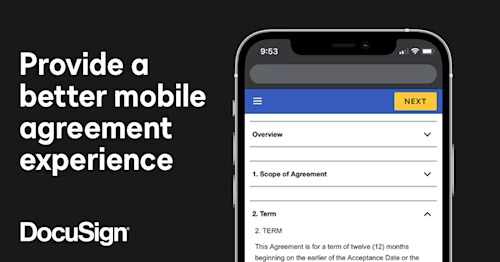
Share the knowledge: Taking your system of agreement to the next level
A webinar into embracing modern systems of agreement in your digital transformation journey. Don't transform your business without it.

We recently ran a webinar, Embracing modern systems of agreement- don't transform without it, where Docusign senior marketer, Natalie McKay, facilitated a conversation between Michael Barnes, VC and Research Director at Forrester, Kedar Viswanathan Head of Technology, Market Unit Functions at Bupa and myself, Andy Thiss, Regional Vice President, Docusign APAC.
During this webinar we received some really interesting questions that we have seen come up a few times, so we thought other Docusign users might benefit from hearing the responses.
So, without further adieu, please see some of the questions asked off the back of the Embracing modern systems of agreement- don't transform without it webinar:
How do Docusign customers integrate their in-house system with Docusign, so that document are easily submitted to clients for approval, and signed documents are sent back into our system?
Firstly, Docusign has a plug and play connection with over such as Salesforce, SAP and Microsoft Stack. If your business has a custom system or you use something outside of one of our current connections, the Docusign API allows us to create bespoke integrations.
Next step would be to sit down with a team member and walk through what system you’re using, also how you want the flow of your system of agreements to run and what actions you want triggered. This consultation process can be really helpful as our team has seen how loads of systems are set up and may have some creative thoughts and suggestions.
What are some of the risks and challenges that new Docusign customers face?
Kedar took the lead on this question and said that the hurdle he faced getting Docusign off the ground within BUPA was getting buy in from the legal team. He mentioned that once the legal team had a few conversations with Docusign and were assured that all signatures were legally binding, their minds were at ease. The legal team’s sign off gave other departments the confidence to implement themselves.
Kedar then went on to explain that it’s then on going, small, quite specific questions from various departments. “It's about walking them through the actual time wasted, and costs of not using Docusign. Then the story becomes a lot better. Just working through each of those, I would call it hurdles that they come along. You'll generally find that they're not that difficult to overcome.”
Michael agreed with Kedar’s observations adding that the processes before and after the eSignature was the hardest part. Once internal stakeholders saw the streamlining and efficiency of an end to end system that saves time and money, they are more likely to get on board.
Which departments within organisations are most likely to use Docusign?
I loved this question because I could talk about each area within a business Docusign has a solution for, but we would have been on air for hours!
I used BUPA as an example. When we started working with BUPA and Kedar we wanted to make sure that we understood and analyzed, what the key drivers for the business are. Once we had that mapped out we worked out how Docusign fit into the picture.
More generally, the prepare phase sees team like legal, finance, sales, HR, setting up and sending agreements via platforms like Salesforce and SAP. When it comes to the signing phase, we are applicable across every department of any business. Finally, the management of those agreements usually comes back to those preparing and sending them out. Streamlining the process saves time, money and the environment, something we can all get behind.
Catch the webinar here.
Related posts
Discover what's new with Docusign IAM or start with eSignature for free


